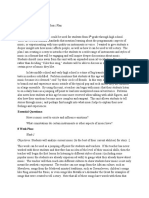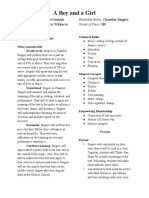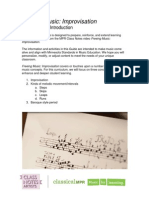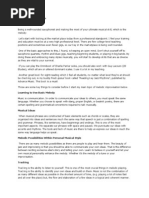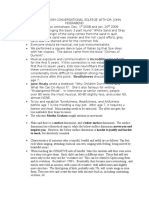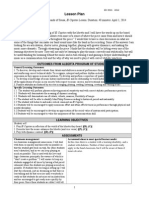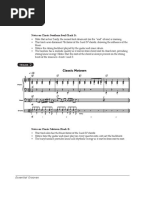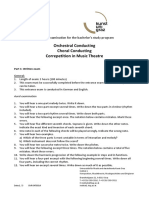Improvisation Strategies and Resources, Part 2: by Herbert D. Marshall
Improvisation Strategies and Resources, Part 2: by Herbert D. Marshall
Uploaded by
maria ballesterosCopyright:
Available Formats
Improvisation Strategies and Resources, Part 2: by Herbert D. Marshall
Improvisation Strategies and Resources, Part 2: by Herbert D. Marshall
Uploaded by
maria ballesterosOriginal Description:
Original Title
Copyright
Available Formats
Share this document
Did you find this document useful?
Is this content inappropriate?
Copyright:
Available Formats
Improvisation Strategies and Resources, Part 2: by Herbert D. Marshall
Improvisation Strategies and Resources, Part 2: by Herbert D. Marshall
Uploaded by
maria ballesterosCopyright:
Available Formats
Improvisation Strategies and Resources, Part 2
By Herbert D. Marshall
Herbert Marshall is assistant professor of music education at The University of
Michigan, Ann Arbor. E-mail: hdm@umich.edu.
T
his is a follow-up to my Spring 2004 duration and interesting to the students. Tonal
column from General Music Today, in patterns should be 2–4 pitches that outline one
which I discussed improvisation in harmonic function; e.g., do–sol–do and sol–mi–-
different styles and shared different resources do are tonic (I) patterns, re–ti–re and re–ti–sol
for improvisation materials. In this column, I are dominant (V) patterns. Notice that these
intend to share techniques to help you start patterns resemble ostinati you might use from
nourishing creativity, or perhaps new ideas to a singing game or Orffestration. Teach simple
try with your students. To help clarify my songs and chants in major, minor, duple, and
expectations and classify student responses, I triple, with obvious phrases, motives, and
use the following terms and definitions: repetition—pieces that follow a predictable
Exploration. Finding personal boundaries, form. When your precocious students start to
using all options, pushing limits. May involve become too familiar with the song or chant,
little preparation, more spontaneity, building you will be able to harness that
confidence, permitting divergent opinions. energy—convert that boredom—by inviting
Creativity. Applying some conditions or them to invent a new twist for the song.
limits, but allowing for great diversity of Establish simple hand signals or signs that
choices. May involve some planning. Building mean “same” and “different.” It must be
a useable repertoire of possible responses. absolutely clear when you want students to
Improvisation. More defined expectations, respond the same as you (like an echo song)
parameters. If there is not a correct or incor- versus responding differently from you (on
rect response, at least there are musical ideas your hand drum, play a pattern that is different
from the learner’s repertoire that are obviously from mine). Movement is an excellent way to
better choices than others. begin, because children already play mirroring
games like Simon Says. Ideas:
1. Tim is the leader. At the end of the first
How To Start
verse, freeze into a statue-shape that is exactly
First, you must have good class control and like Tim’s shape. At the end of the second
rapport with and among students, and the verse, freeze into a shape that is very different
students must know a wide repertoire of from Tim’s shape.
songs, chants, and patterns. Keep it simple! 2. We’re singing a song about playing football
Rhythm patterns should be 2–4 beats in today. I’m thinking about the movement
GMT Fall 2004 37
players use when there is a bone-crushing dominant to tonic, such as “This Old Man,”
tackle. With a partner, think of all the move- “Row, Row, Row Your Boat,” or “Long, Long
ments you might see on a football field that Ago.” Sing without words so as to focus only
are different from that tackling movement. on the musical task. Ask individuals if they can
In my experience, once they have success- invent a new ending to the song that starts on
fully used their bodies—and observed their sol and ends on do but gets to do in a new way.
peers—acting out “same” and “different,” You’ve probably taught them enough
most children will be willing to play or chant dominant-tonic cadence formulas to provide
rhythms that are different from those of their many optional endings. Remember to limit the
teacher or peers. Ideas: ending to a certain number of pitches or a
1. Teach a song or chant that is enhanced by specific number of beats unless you have time
rhythmic accompaniment such as “The Noble to treat yourself to a few diva cadenzas!
Duke of York” or “Are You Sleeping.” After If students can invent endings, then they
students have mastered a rhythmic ostinato to can invent variations on other parts of the
the piece, have them work in groups to create tune. For this, it is best to start with tunes that
a new pattern to repeat. can be harmonized using only two chords,
2. To assess individuals, pause the piece in the such as tonic and dominant. You may be
middle to open up a 4- or 8-beat solo break. inclined to start with pentatonic melodies, but
First the teacher models a rhythmic solo, then I would use that only as a brief readiness
students perform solos. If this is their first activity. I find that children get bored quickly
solo performance, give students some think when there is no dissonance, because it is the
time to work out their ideas. dissonance that will guide them to find the
Use same and different movement and best fit. When we’re improvising in pentatonic,
rhythm activities to lay the foundation, and I can never quite tell if they’re making musical
praise students who take risks. For some decisions or simply noodling around the
students, it takes a long time to be comfortable pitches.
with the process of exploring or creating—it’s “Polly Wolly Doodle” and “Long, Long
easier to imitate. When most of your students Ago” are good tunes in the major
have a good sense of pitch and are using tonic/dominant category; “Joshua” and “Zum
singing voices, transition into tonal creativity. Gali Gali” are examples in minor tonality. I’ve
Ideas: had even more success with modal tunes that
1. Ask the class to reverse or invert 2- and 3- use only tonic and subtonic, such as “Drunken
pitch patterns. You might sing do–mi–sol and Sailor,” “Oh, Sinner Man,” and “Old Joe
guide the students to sing sol–mi–do or another Clark.” By limiting choices in this manner, the
variation on your pattern. Do the same with students can concentrate on making changes at
dominant patterns. Use the patterns on voices obvious and predictable points in the song and
or pitched percussion to accompany can formulate a plan. I urge you to hear
tonic/dominant songs students improvise with their voices before
2. Sing simple folk melodies that have a brief you transfer these ideas to instruments such as
final phrase that melodically moves from pitched percussion or recorders. You will learn
GMT Fall 2004 38
much more about what is actually going on in attempts to nurture spontaneous improvisa-
their audiation and reinforce the idea that tion only produced groups of children who
singing is the core of what we do. While I spontaneously refuse to improvise. When I got
agree that we are working with a wide diversity up the nerve to revisit this process, I had
of vocal ability, I have found improvisation to much more success with a sequential approach
be a great relief in this regard. Students can and a “safety net” of parameters. These
choose their most reliable tempo and tessitura. activities have become my favorites in the
Many students will find this a liberating and classroom, because students beam when they
rewarding exercise. perform their own musical ideas, and I learn
I realize that some adhere to the definition so much more about what musical skills they
of improvisation as spontaneous creativity possess and can access. This year, I urge you
whereas I am advocating parameters, planning, to try this process. You’ll love it.
and time to think. That is because I, like many
of you, found that in primary school my
GMT Fall 2004 39
You might also like
- BERKLEE - Song Writing PDFDocument25 pagesBERKLEE - Song Writing PDFDreyden Halo100% (19)
- The 6 Essential Chords in Every KeyDocument7 pagesThe 6 Essential Chords in Every KeyVlado Petkovski100% (1)
- Choir Training For BeginnersDocument5 pagesChoir Training For BeginnersEugyne Jie Ying100% (3)
- Lenny Kravitz Best of PDFDocument58 pagesLenny Kravitz Best of PDFFranck UrsiniNo ratings yet
- GORDON, Edwin - Music LearningDocument0 pagesGORDON, Edwin - Music Learningdvm1010100% (1)
- Bossa MethodDocument23 pagesBossa MethodBrunella Toro100% (10)
- Cuphead Symphonic SuiteDocument68 pagesCuphead Symphonic SuiteAo973No ratings yet
- Stacey Kent Jardin D Hiver PDFDocument1 pageStacey Kent Jardin D Hiver PDFMester KingaNo ratings yet
- Early Mendelssohn and Late BeethovenDocument15 pagesEarly Mendelssohn and Late BeethovenEren GumrukcuogluNo ratings yet
- 17th Century Violin - TechniqueDocument46 pages17th Century Violin - TechniqueVictor TamarindoNo ratings yet
- Tugas NikeDocument7 pagesTugas Nikethe D 23No ratings yet
- How To Use Songs in The English Language ClassroomDocument5 pagesHow To Use Songs in The English Language ClassroomSandra Rodríguez CaballeroNo ratings yet
- Choral Teaching Sequence 1Document2 pagesChoral Teaching Sequence 1api-511022719No ratings yet
- What Is Rote Learning?Document4 pagesWhat Is Rote Learning?Michelle Facun MorenoNo ratings yet
- Teaching Language Arts Through Song (Children)Document2 pagesTeaching Language Arts Through Song (Children)Ayaka NaomiNo ratings yet
- John Paul MUSIC LESSON 4-5 MODULEDocument6 pagesJohn Paul MUSIC LESSON 4-5 MODULEJohn Paul SanchezNo ratings yet
- 12.how To Use Songs in The English Language ClassroomDocument5 pages12.how To Use Songs in The English Language ClassroomEziaNo ratings yet
- Observation 1Document2 pagesObservation 1api-188751688No ratings yet
- TEAM Lesson Plan Template: UT MartinDocument5 pagesTEAM Lesson Plan Template: UT Martinapi-253217748No ratings yet
- Elementaryteachingunit 1Document52 pagesElementaryteachingunit 1api-357472068No ratings yet
- Revised Mini Lesson of Peg Leg The PirateDocument5 pagesRevised Mini Lesson of Peg Leg The Pirateapi-371835039No ratings yet
- Music Key Stage 1 & 2 - Schemes of Work - Unit 4Document15 pagesMusic Key Stage 1 & 2 - Schemes of Work - Unit 4Ju-Rey Delos Reyes ForondaNo ratings yet
- SecondarylessonplanDocument5 pagesSecondarylessonplanapi-242822715No ratings yet
- Elementary UnitDocument39 pagesElementary Unitapi-526541358No ratings yet
- A Boy and A Girl-Eric Whitacre Rehearsal PlanDocument3 pagesA Boy and A Girl-Eric Whitacre Rehearsal Planapi-314357293No ratings yet
- m344 Peer Repertoire Teaching Reflection GuidelinesDocument4 pagesm344 Peer Repertoire Teaching Reflection Guidelinesapi-380245101No ratings yet
- Group 10 MusicDocument6 pagesGroup 10 MusicOdyssey Bunquin LaganNo ratings yet
- WEEK2MU101Document35 pagesWEEK2MU101Alyssa LazaroNo ratings yet
- Year 10 Film MUSIC UNIT Cashmere High School Teacher: Grant BartleyDocument8 pagesYear 10 Film MUSIC UNIT Cashmere High School Teacher: Grant BartleySeraLevingsNo ratings yet
- STP Lesson 1Document4 pagesSTP Lesson 1api-708879615No ratings yet
- Ce-Melodic Dictation Links Online 2Document8 pagesCe-Melodic Dictation Links Online 2Stratis SgourellisNo ratings yet
- Improvisation Curricula PDFDocument6 pagesImprovisation Curricula PDFclassicalmprNo ratings yet
- Teaching Basic Jazz Improvisation - Tips and Music ExamplesDocument6 pagesTeaching Basic Jazz Improvisation - Tips and Music ExamplesEric Rodriguez100% (1)
- Stong Vs Weak BeatsDocument3 pagesStong Vs Weak Beatsapi-236204696No ratings yet
- Melodic ImprovisationDocument3 pagesMelodic Improvisationjimbob61No ratings yet
- Drum ImprovDocument3 pagesDrum Improvdl1485No ratings yet
- Hava Nagila Lesson 3Document4 pagesHava Nagila Lesson 3api-316334860No ratings yet
- Inspiring Your Rehearsal: Rocks and SandDocument8 pagesInspiring Your Rehearsal: Rocks and SandAustin BaduriaNo ratings yet
- Introduction To STPDocument11 pagesIntroduction To STPapi-711340770No ratings yet
- Conversational Solfege HighlightsDocument12 pagesConversational Solfege Highlightsanthonyhealy25No ratings yet
- Elementary WMP UnitDocument29 pagesElementary WMP Unitapi-533606010100% (1)
- 10 Play It Again - Exploring Rhythmic PatternsDocument3 pages10 Play It Again - Exploring Rhythmic PatternsAndyBrooke100% (1)
- ĐỀ 1 PPGDDocument3 pagesĐỀ 1 PPGDMinh HằngNo ratings yet
- Lg5e PD SongschantsDocument2 pagesLg5e PD Songschantsselsabilhaddab2004No ratings yet
- Music Lesson 4Document7 pagesMusic Lesson 4Beatriz CincoNo ratings yet
- Uniting Orff and Kodaly Resource PacketDocument53 pagesUniting Orff and Kodaly Resource PacketRyanMPeters100% (1)
- Mepaforpst11 8 13Document2 pagesMepaforpst11 8 13api-250049172No ratings yet
- April 1 Hs BandDocument3 pagesApril 1 Hs Bandapi-238119018No ratings yet
- Elementary Unit: Fa: 4 Grade Michael Fibelkorn 2 November 2017Document37 pagesElementary Unit: Fa: 4 Grade Michael Fibelkorn 2 November 2017api-357689913No ratings yet
- Using Songs in The English ClassroomDocument10 pagesUsing Songs in The English ClassroomIrdawati Shuib100% (1)
- Gulli-Ubd PlanningDocument3 pagesGulli-Ubd Planningapi-370091709No ratings yet
- Teaching Philosophy: An Twelve-Page Discussion On Teaching Practices and Student InvolvementDocument12 pagesTeaching Philosophy: An Twelve-Page Discussion On Teaching Practices and Student InvolvementYang LiuNo ratings yet
- 4 Lesson PlansDocument12 pages4 Lesson Plansapi-273975851100% (1)
- Activities Suggestions - Teaching English With Songs and MusicDocument4 pagesActivities Suggestions - Teaching English With Songs and MusicEugenio Mondejar100% (1)
- Piano PracticeDocument5 pagesPiano PracticeJulian GonzalezNo ratings yet
- A Lesson With TPDocument3 pagesA Lesson With TPJorge BarataNo ratings yet
- The Dos and Don'Ts of Directing A Church ChoirDocument6 pagesThe Dos and Don'Ts of Directing A Church ChoirChristianNo ratings yet
- Lesson Plan 4-Unit PlanDocument6 pagesLesson Plan 4-Unit Planapi-426119630No ratings yet
- Fielding-Mus149-Assignment 4Document4 pagesFielding-Mus149-Assignment 4api-510874732No ratings yet
- Discussion PostsDocument9 pagesDiscussion Postsapi-676749218No ratings yet
- Emotions Lesson Plan TCH 210Document4 pagesEmotions Lesson Plan TCH 210api-433518907No ratings yet
- Helpful Hints For Running A Successful School ChoirDocument9 pagesHelpful Hints For Running A Successful School Choirrosarubra21No ratings yet
- SingingDocument22 pagesSingingRica Julea DacaraNo ratings yet
- Introducing A SongDocument5 pagesIntroducing A SongSimona Brezan AioaniNo ratings yet
- Improve your teaching! Teaching Beginners: A New Approach for Instrumental and Singing TeachersFrom EverandImprove your teaching! Teaching Beginners: A New Approach for Instrumental and Singing TeachersRating: 4 out of 5 stars4/5 (1)
- Straight FunkDocument1 pageStraight Funkmaria ballesterosNo ratings yet
- Second Line FunkDocument1 pageSecond Line Funkmaria ballesterosNo ratings yet
- Notes On Classic Southern Soul (Track 1)Document1 pageNotes On Classic Southern Soul (Track 1)maria ballesterosNo ratings yet
- Urban FunkDocument1 pageUrban Funkmaria ballesterosNo ratings yet
- Seventies Funk in The James Brown Style: Notes On Early Funk (Track 6)Document1 pageSeventies Funk in The James Brown Style: Notes On Early Funk (Track 6)maria ballesterosNo ratings yet
- Classics Groove 1Document1 pageClassics Groove 1maria ballesterosNo ratings yet
- Itegy: Using Improv Teaching StraDocument6 pagesItegy: Using Improv Teaching Stramaria ballesterosNo ratings yet
- Helpful Literature Helpful Literature Helpful Literature: American Music American Music American MusicDocument2 pagesHelpful Literature Helpful Literature Helpful Literature: American Music American Music American Musicmaria ballesterosNo ratings yet
- Impro IVDocument8 pagesImpro IVmaria ballesterosNo ratings yet
- Creative Teaching: Collaborative Discussion As Disciplined ImprovisationDocument9 pagesCreative Teaching: Collaborative Discussion As Disciplined Improvisationmaria ballesterosNo ratings yet
- Impro XIDocument8 pagesImpro XImaria ballesterosNo ratings yet
- Imitation, Interaction and Imagery: Learning To Improvise Drawing With MusicDocument15 pagesImitation, Interaction and Imagery: Learning To Improvise Drawing With Musicmaria ballesterosNo ratings yet
- Impro IIIDocument14 pagesImpro IIImaria ballesterosNo ratings yet
- Lessons From Lithuania: A Pedagogical Approach in Teaching ImprovisationDocument13 pagesLessons From Lithuania: A Pedagogical Approach in Teaching Improvisationmaria ballesterosNo ratings yet
- Music Improvisation and Composition in The General Music CurriculumDocument9 pagesMusic Improvisation and Composition in The General Music Curriculummaria ballesterosNo ratings yet
- Improvisation As Ability, Culture, and ExperienceDocument7 pagesImprovisation As Ability, Culture, and Experiencemaria ballesteros100% (1)
- Lahing Kayumanggi 07 - Flute 1Document4 pagesLahing Kayumanggi 07 - Flute 1Bombie CustodioNo ratings yet
- Capstone Project Proposal 1Document7 pagesCapstone Project Proposal 1api-596258184No ratings yet
- Dont Doubt Him Now - Brass Ensemble Accompaniment-FlugelhornDocument1 pageDont Doubt Him Now - Brass Ensemble Accompaniment-FlugelhornAna Belén CondoriNo ratings yet
- Speechless: Aladdin (2019)Document12 pagesSpeechless: Aladdin (2019)Marina VlachakiNo ratings yet
- Sawan Aaya Hai Beginner Piano Staff Notation by Vishal BagulDocument7 pagesSawan Aaya Hai Beginner Piano Staff Notation by Vishal BagulMamata HebbarNo ratings yet
- Bach Goldberg Variations 3GDocument82 pagesBach Goldberg Variations 3GS.RobertNo ratings yet
- Alf0024860 1Document3 pagesAlf0024860 1mikitos50% (2)
- Tension 13: 5or1 He T TH Ro No H RD inDocument1 pageTension 13: 5or1 He T TH Ro No H RD inmarcoanteloNo ratings yet
- Music3g - Music of The Romantic PeriodDocument3 pagesMusic3g - Music of The Romantic PeriodRonnel Andres HernandezNo ratings yet
- 1587251-God Only Knows For Saxophone QuartetDocument4 pages1587251-God Only Knows For Saxophone QuartetMarcos JNo ratings yet
- Graz BachelorDocument3 pagesGraz BachelorJeisson0122No ratings yet
- Voice Area Handbook: School of MusicDocument23 pagesVoice Area Handbook: School of MusicM. LorenzoNo ratings yet
- George Crumb &: Black AngelsDocument15 pagesGeorge Crumb &: Black AngelsPrateep SuphanrojnNo ratings yet
- Band Balance and Seating ChartsDocument8 pagesBand Balance and Seating Chartssaxgoldie100% (2)
- 06 07 ChordsHarmonicSonorities PDFDocument1 page06 07 ChordsHarmonicSonorities PDFDilson Colman CassaroNo ratings yet
- History of Music AnalysisDocument5 pagesHistory of Music AnalysisskyjuliesjsNo ratings yet
- Reverie-Debussy Klarinette in BDocument2 pagesReverie-Debussy Klarinette in Bgil.schwartzfreenet.deNo ratings yet
- The Orchestra Complete 2 Manual en 2.0Document29 pagesThe Orchestra Complete 2 Manual en 2.0man pianistaNo ratings yet
- Prelude in B MinorDocument2 pagesPrelude in B MinorThayse GarciaNo ratings yet
- Theme Elaboration Techniques in 20 - Century Fugue: "George Enescu" National University of Arts, Iasi, RomaniaDocument7 pagesTheme Elaboration Techniques in 20 - Century Fugue: "George Enescu" National University of Arts, Iasi, RomaniagabrielavlahopolNo ratings yet
- Compendium - Music 6 - Quarter 1Document3 pagesCompendium - Music 6 - Quarter 1Jhune Valdez GandolaNo ratings yet
- Basics of The Basics of Lute Continuo 1994 Wikla, Arto Laúd 8 Páginas PDFDocument8 pagesBasics of The Basics of Lute Continuo 1994 Wikla, Arto Laúd 8 Páginas PDFfiorgal100% (1)
- Improvisation Organ Four ComposersDocument30 pagesImprovisation Organ Four ComposersJoaquim MorenoNo ratings yet






















